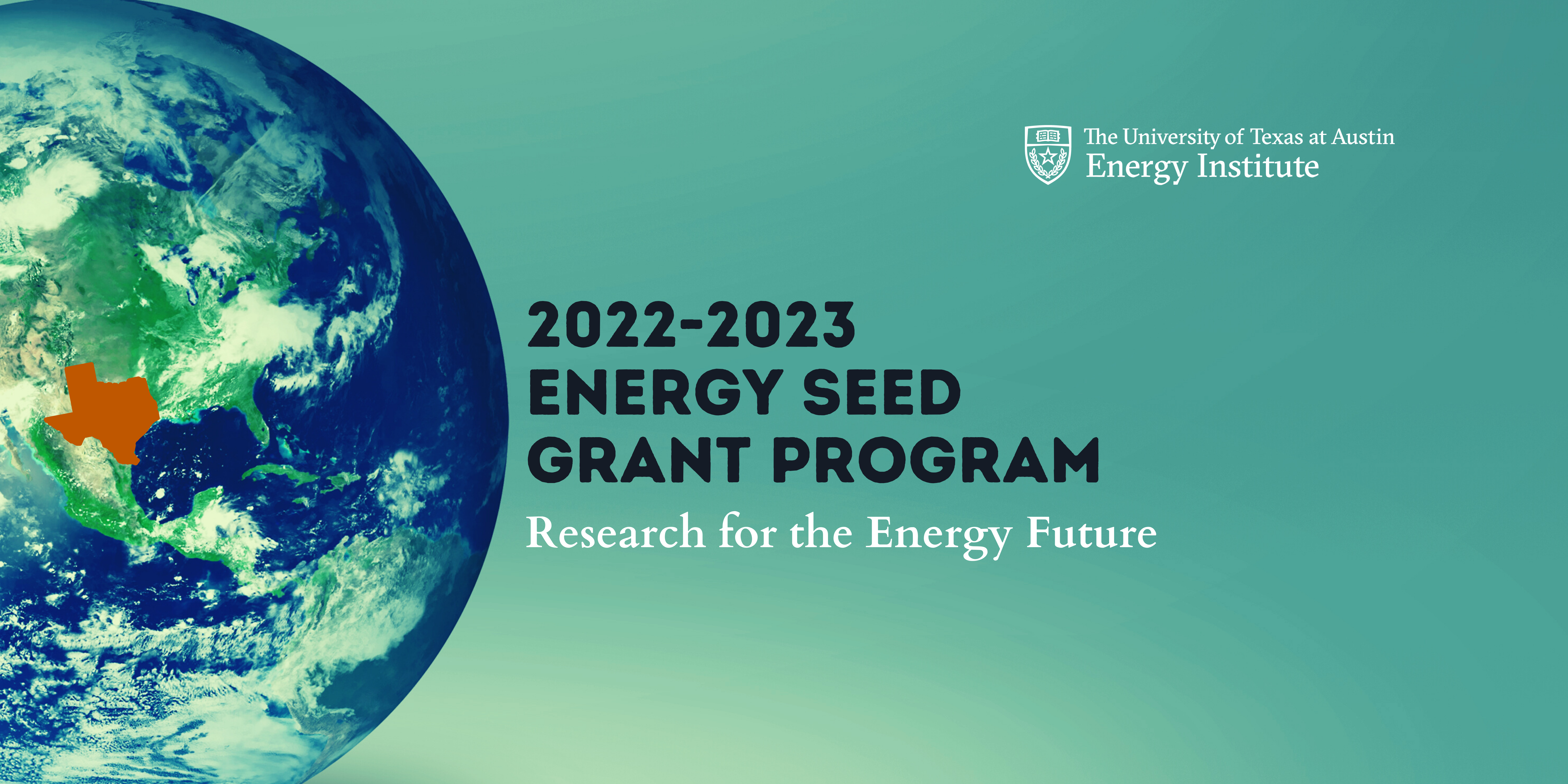
2022-2023 Energy Seed Grant Program
PROGRAM DESCRIPTION
The 2022-2023 Energy Seed Grant Program is a funding opportunity sponsored by the Energy Institute at The University of Texas at Austin to spark new, impactful and collaborative research in any field of energy with an aim towards decarbonization and climate security.
SYNOPSIS OF PROGRAM
Global energy demand continues to rise, while greenhouse gas emissions must fall in order to mitigate the impacts of climate change. Addressing this, while ensuring equitable access to energy is one of the greatest challenges facing society. Many governments and companies have set ambitious goals to achieve net zero carbon emissions by 2050; however, the technologies and policies needed to achieve these goals do not fully exist. The 2022-2023 Energy Seed Grant Program aims to accelerate the scientific, engineering, technological, technoeconomic and policy innovations needed to achieve these climate goals.
This opportunity is open to all fields of energy research, but these four topical areas are of particular relevance:
Carbon Management or CCUS (utilization via all pathways including biological). A future with net zero carbon emissions will require technology and policy advances in carbon capture—including point source and direct air capture (DAC)—carbon storage, and carbon utilization—i.e., the conversion of CO2 to useful products. These approaches might include the development of new catalysts, tools of synthetic biology and nature-based solutions, among others. The generation of clean hydrogen from natural gas requires effective carbon capture, storage and utilization strategies. Research addressing technoeconomic hurdles and opportunities, and government policy frameworks that could promote/hinder development or build-out are of particular interest.
Low and Zero-Carbon Fuels and Distributed Energy Resources (DERs). Renewable energy sources, such as wind, solar, biofuels, and geothermal will provide critical resources for generating low-carbon electricity and low- to no-carbon fuels. Long-duration, daily-to-monthly, energy storage technologies will be required to manage the intermittency of solar and wind. Clean hydrogen can be generated and used or converted to NH3, methanol or formate for example, for transport and later use in a wide range of chemicals, biofuels and biological and materials processes. Plastics production and use must be made more sustainable. The widespread emergence of electric vehicles (i.e., e-mobility) and the potential for bidirectional charging—so-called vehicle-to-home (V2H), vehicle-to-grid (V2G) or vehicle-to-anything (V2X)—are providing new opportunities for reducing carbon emissions and improving our energy resiliency. In addition to the numerous technology hurdles, the appropriate mix of these many options will vary by region and country and be determined by policy-enabled markets (for early adoption), which need to be understood. Seed ideas for hard-to-abate challenges (such as long-distance transportation, including shipping and aviation among others) are especially encouraged.
Industrial [Chemical/thermal (heat)] Decarbonization. Industrial processes account for about 25% of all global greenhouse gas emissions, and these carbon emissions are rising much more rapidly than carbon emissions in the power, transportation and buildings sectors. About 45% of industrial GHG emissions arise from manufacturing steel, cement, ammonia and ethylene, which come from the feedstocks and raw materials (45%), high-temperature heat generation (35%) and additional fuels burned to generate low- and medium-heat (20%). Electrification of industrial processes provides a route to decarbonization, but faces significant technological challenges. Carbon emissions are inherent to the chemical processes currently used to make these materials, because not only are there significant carbon emissions associated with the energy produced to drive the manufacturing, but CO2 is also emitted as a byproduct of the reactions used to make these materials and chemical products. Alternative materials, chemistry, feedstocks and process paths are needed. As an example of the magnitude of this challenge, to meet the clean hydrogen standard set forth in the infrastructure bill, the amount of CO2 produced per kg of H2 needs to decrease from nearly 10 kg of CO2/kg of H2 to less than 2 kg of CO2/kg of H2. There are opportunities to minimize and eliminate wastes using advanced manufacturing strategies, such as additive manufacturing (3D printing), circular economy (for plastics, water, critical materials, etc.) and waste-to-X opportunities, where X can be H2, power, etc.
Power Value Chain Decarbonization. This sector has one of the highest potentials for lowering carbon footprint, especially through higher integration of renewables in the grid. Opportunities exist with grid expansion/efficiency, CCUS enablement in existing infrastructure, and distributed energy resources integration without/with energy storage and hybrids including SMART grid/home/vehicle inter-connects for more-than-one-way power transmission/distribution.
ELIGIBILITY
Estimated Number of Awards: 17
Maximum Total Funding Per Project: $60,000
Award Duration: 1 year
Letters of Support Required: Each proposal is required to have at least one letter of support from an external partner—a company, a governmental entity, or a foundation or philanthropic organization. The letter(s) should indicate the importance of the work and indicate that there is high probability for follow-on funding after the close of the seed project research period.
Matching Funds (Optional): Though not required, proposals can include matching funds. Proposals with matching fund contributions will be viewed favorably.
DOWNLOAD COMPLETE PROGRAM GUIDELINES
PROGRAM TIMELINE
|
May 2, 2022 |
Request for Proposals (RFP) Released |
|
July 1, 2022 |
Proposals Due (5:00 PM Central Standard Time) |
|
August 1, 2022 |
Awards Announced |
|
September 1, 2022 |
Performance Period Begins (Funds Available) |
|
August 31, 2023 |
Performance Period Ends |
|
October 1, 2023 |
Final Report Due |

2022-2023 Seed Grant Awards
The Energy Institute at The University of Texas at Austin has awarded seed grants to 17 interdisciplinary research teams to help kickstart projects that will attract federal funding and accelerate the innovations needed to reduce the impact of fossil fuels on the environment.
Contact:
Christa Hopkins,
Senior Administrative Associate
